Product Design and Development Exam 1
1/97
There's no tags or description
Looks like no tags are added yet.
Name | Mastery | Learn | Test | Matching | Spaced |
|---|
No study sessions yet.
98 Terms
Product quality
How good is the product resulting from the development effort? Satisfies customer needs? Robust and reliable? Ultimately reflected in market share and the price customers pay.
Product cost:
What is the manufacturing cost? Cost includes spending on capital, equipment, and cost of producing each unit of product. Determines how much profit accrues to the firm for a particular sales volume and a particular sales price.
Development time:
How quickly did the team complete the product development effort? Determines how responsive firm can be to competitive forces and to technological developments, as well as how quickly the firm receives the economic returns from the team’s efforts.
Development cost
How much did the firm have to spend to develop the product? Is usually a significant fraction of the investment required to achieve the profits.
Development capability
Are the team and the firm better able to develop future products as a result of their experience with a product development project? Is an asset the firm can use to develop products more effectively and economically in the future.
Characteristics of Successful Product Development
Product Quality
Product Cost
Development Time
Development Cost
Development Capability
Who designs and develops products
Marketing
Design
Manufacturing
Challenges of Product Development
Trade-offs
Dynamics
Details
Time Pressure
Economics
Appeals of Product Development
Creation
Satisfaction of societal and individual needs
Team diversity
Team spirit
Organizational realities
Lack of empowerment of team
Functional allegiances transcending project goals
Inadequate resources
Lack of cross-functional representation on the project team
Well-defined product development process is useful for the following reasons
Quality assurance
Coordination
Planning
Management
Improvement
Phases of generic product development
Planning
Concept development
System-level design
Detail design
Testing and refinement
Production ramp-up
Planning
Precedes the approval and launch of development process. Begins with opportunity identification. Includes assessment of technology developments and market objectives. Output is mission statement.
Mission statement
Specifies target market for the product, business goals, key assumptions, and constraints.
Concept development: (pg. 15)
Needs of the target market are identified. Alternative product concepts generated and evaluated. 1 or more concepts selected for further development and testing
Concept
Description of the form, function, and features of a product. Usually accompanied by a set of specifications, and analysis of competitive products, and an economic justification.
System-level design
Includes definition of product architecture, decomposition of product into subsystems and components, preliminary design of key components, and allocation of detail design responsibility to internal and external resources. Initial plans for production system and final assembly are usually defined during this phase as well. Output of this phase usually includes geometric layout of product, functional specification of each subsystem, and preliminary process flow diagram for final assembly process.
Detail design
Includes complete specification of geometry, materials, and tolerances of all unique parts, and identification of all standard parts to be purchased. Process plan is established, tooling designed for each part. Output is control documentation.
Control documentation
Drawings or computer files describing geometry of each part and its tooling, spec’s of purchased parts, production supply chain, and process plans for fabrication and performance.
Testing and refinement
Involves the construction and evaluation of multiple pre-production versions of product.
Alpha prototype
Usually built with production-intent parts—parts with the same geometry and material properties as intended for the production version of the product but not necessarily fabricated with the actual processes to be used in production. Tested to determine if the product will work as designed and if it satisfies key customer needs.
Beta prototype
Usually built with parts supplied by the intended production processes but may not be assembled with final assembly process. Are extensively evaluated internally and also tested by customers in their own use environment. Goal is usually to answer questions about performance and reliability, and to identify necessary engineering changes for final product.
Production ramp-up: (pg. 15)
Product is made using intended production system. Purpose is to train workforce and work out any remaining problems in production process. Products produced during this are sometimes supplied to preferred customers and carefully evaluated to identify any remaining flaws.
Concept Development process
Identify customer needs
Establish target specifications
Concept generation
Concept selection
Concept testing
Setting final specifications
Project planning
Economic analysis
Benchmarking of competitive products
Modeling and prototyping
Technology-push products
New proprietary technology pushes product development
Generic market-pull products
Market opportunity drives product development.
Platform products
Product is built around preexisting technological subsystem.
Process-intensive products
Characteristics of the product are highly constrained by the production process, so that product design cannot be separated from production process design.
Customized products: (pg. 20)
Slight variations on standard products. Typically developed in response to a specific order by a customer. Development consists primarily of setting values of design variables such as physical dimensions and materials.
High-risk products
Addresses many types of risk including technical risk, market risk, budget, and schedule risk. These products entail unusually large uncertainties of tech or market so that there is large tech or market risk. (Generic product development process is modified by taking steps to address the largest risks in the early stages of product development.)
Quick-build products
Design-build-test cycle is repeated many times. Has high-, medium-, and low- priority features. Uses the result of each cycle to learn how to modify the priorities of the next cycle. Customers may even be involved in the testing process after one or more cycles.
Digital products: (pg. 21)
Developed using a highly-iterative product development process. Often developed incrementally, beginning with basic functions and building up to the complete system with many iterations.
Product-service systems: (pg. 21)
Often provided in conjunction with tangible products. Largely developed using the standard product development methods, however, design teams pay careful attention to the range of customer needs and timing of key touch points.
Complex systems: (pg. 22)
Modifications to the generic product development process address a number of system-level issues. The concept development phase considers the architecture of the entire system, and multiple architectures may be considered as competing concepts for the overall system. The system-level design is critical, decomposing into subsystems and further into many components.
Process flow diagrams: (pg. 22)
Depicts the process used to develop the particular product development process adaptation.

Tyco Rally Point process flow: (pg. 23)
Nine phases, with six phases (from concept definition to process verification) comprising the fundamental product development process. Each phase is followed by a critical review, called a “Rally Point,” which is required to gain approval to proceed to the next phase.

Links among groups like designers and developers, formal or informal: (pg. 24)
Reporting relationships
Financial arrangements
Physical layout
Functional organization: (pg. 26)
Organizational links are primarily among those who perform similar functions.
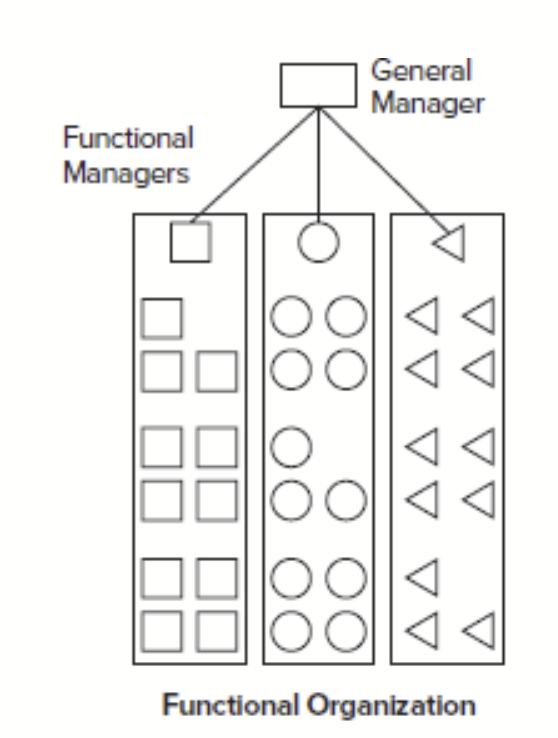
Project organizations: (pg. 26)
The organizational links are primarily among those who work on the same project.
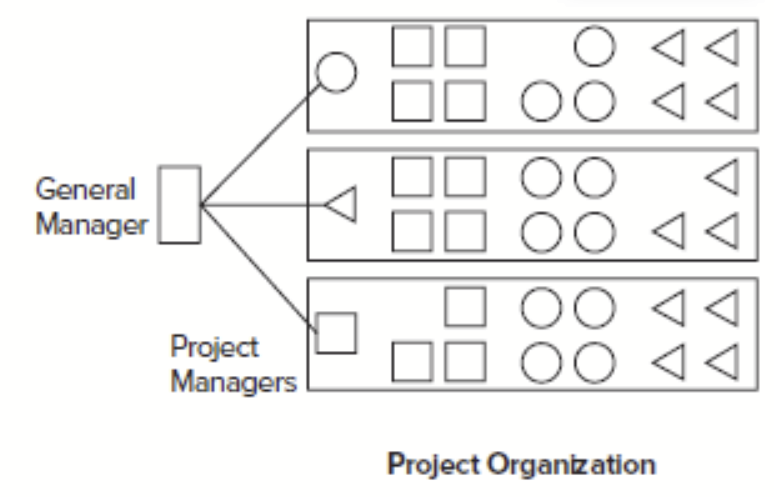
Matrix organization: (pg. 26)
Hybrid of functional and project organizations. In it, individuals are linked to others corresponding to both the project they work on, and their function. Typically, each individual has two supervisors; one project manager and another a functional manager. Practical reality is that either the function or the project tends to have stronger links.
Variants of the matrix organization: (pg. 27)
Heavyweight project organization
Lightweight project organization
Heavyweight project matrix organization: (pg. 27)
Contains strong project links. Project manager has complete budget authority, is heavily involved in performance and evaluation of team members, and makes the most of the major resource allocation decisions.
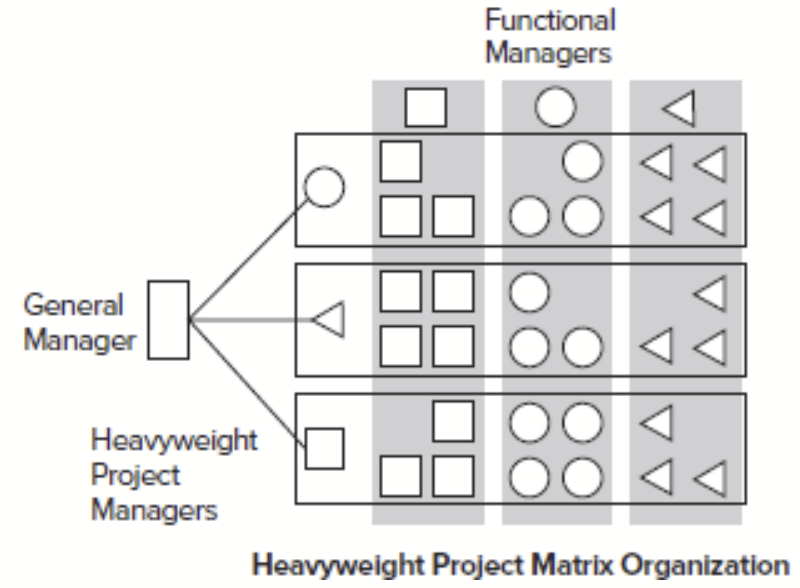
Heavyweight project team in various industries may be called a: (pg. 27)
Product development team (PDT)
integrated product team (IPT)
Design-build team (DBT)
Lightweight project organization: (pg. 27)
Contains weaker project links and relatively stronger functional links. Project manager is more a coordinator and administrator, updates schedules, arranges meetings, and facilitates coordination, but has no real authority or control in the project organization. The managers are responsible for budgets, hiring, and firing, and performance evaluation.
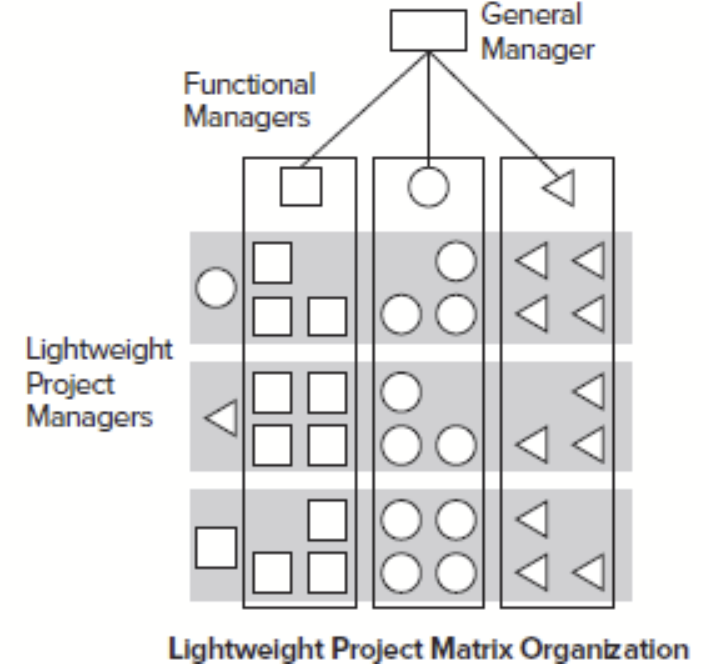
Opportunity: (pg. 36)
An idea for a new product
Dimensions of opportunity: (pg. 36)
The extent to which the team is familiar with the solution likely to be employed
The extent to which the team is familiar with the need that the solution addresses
Types of opportunity: (p. 37)
Horizon 1
Horizon 2
Horizon 3
Horizon 1 opportunity: (pg. 37)
Improvements, extensions, variants, and cost reductions of existing products.
Horizon 2 opportunity: (pg. 37)
Push out into less known territory in either market or technology
Horizon 3 opportunity: (pg. 37)
Attempts to exploit opportunities that are in some way new to the world
Tournament structure of opportunity identification process
Concept development→system-level design→detail design→testing & refinement→production ramp-up
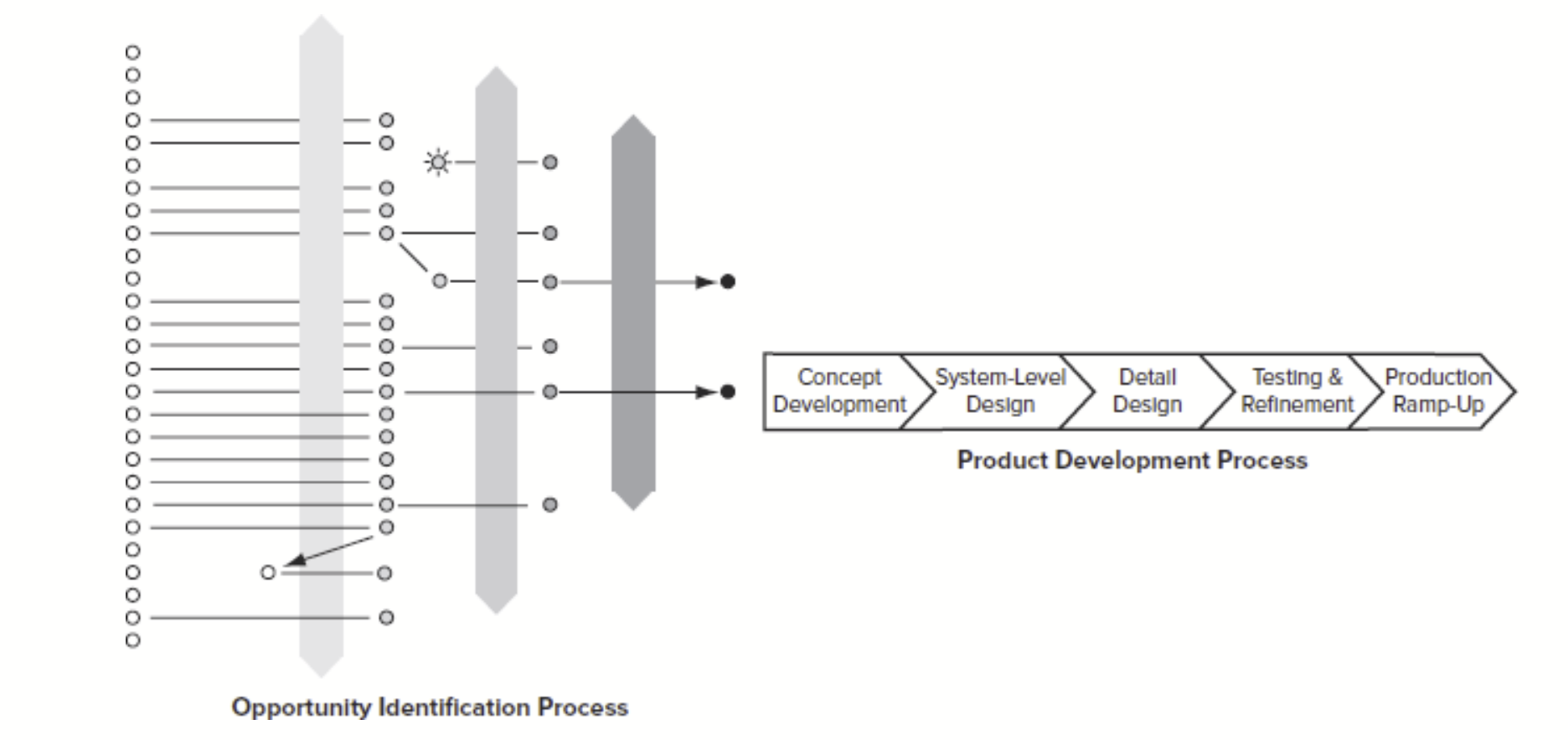
Ways to increase number of excellent opportunities identified
Generate a large number of opportunities
Seek high quality of the opportunities generated
Create high variance in the quality of opportunities
Opportunity identification process
Establish a charter
Generate and sense many opportunities
Screen opportunities
Develop promising opportunities
Select exceptional opportunities
Reflect on the results and the process
Techniques for generating opportunities
Follow a personal passion
Compile bug lists
Pull opportunities from capabilities
Study customers
Consider implications of trends
Imitate, but better
Mine your sources
VRIN: (pg. 43)
Valuable, Rare, Inimitable, Nonsubstitutional
RWW
Real, Win, Worth it
Product plan
Identifies the portfolio of products to be developed by the organization and the timing of their introduction to the market.
Types of product development projects
New product platforms
Derivatives of existing product platforms
Incremental improvements to existing products
Fundamentally new products
Steps in the product planning process
Identify opportunities→evaluate and prioritize projects→allocate resources and plan timing→complete pre-project planning→product development process

Competitive strategies
Technology leadership
Cost leadership
Customer focus
Imitative
Technology leadership
Great emphasis on research and development of new tech, and on deployment of this tech through product development
Cost leadership
Requires firm to compete on product efficiency, either through economics of scale, use of superior manufacturing methods, low-cost labor, or better management of the production system
Customer focus
Firm works closely with new and existing customers to assess their changing needs and preferences.
Imitative
Involves closely following trends in the market, allowing competitors to initially explore which new products are successful for each segment
Perspectives of evaluating and prioritizing projects
Competitive strategy
Market segmentation
Technological trajectories
Product platform planning
Product segment map
Maps competitors’ products and firm’s own products
Technology S-curve
Displays performance of the products in a product category over time
Product platform
The set of assets shared across a set of products
Product platform planning
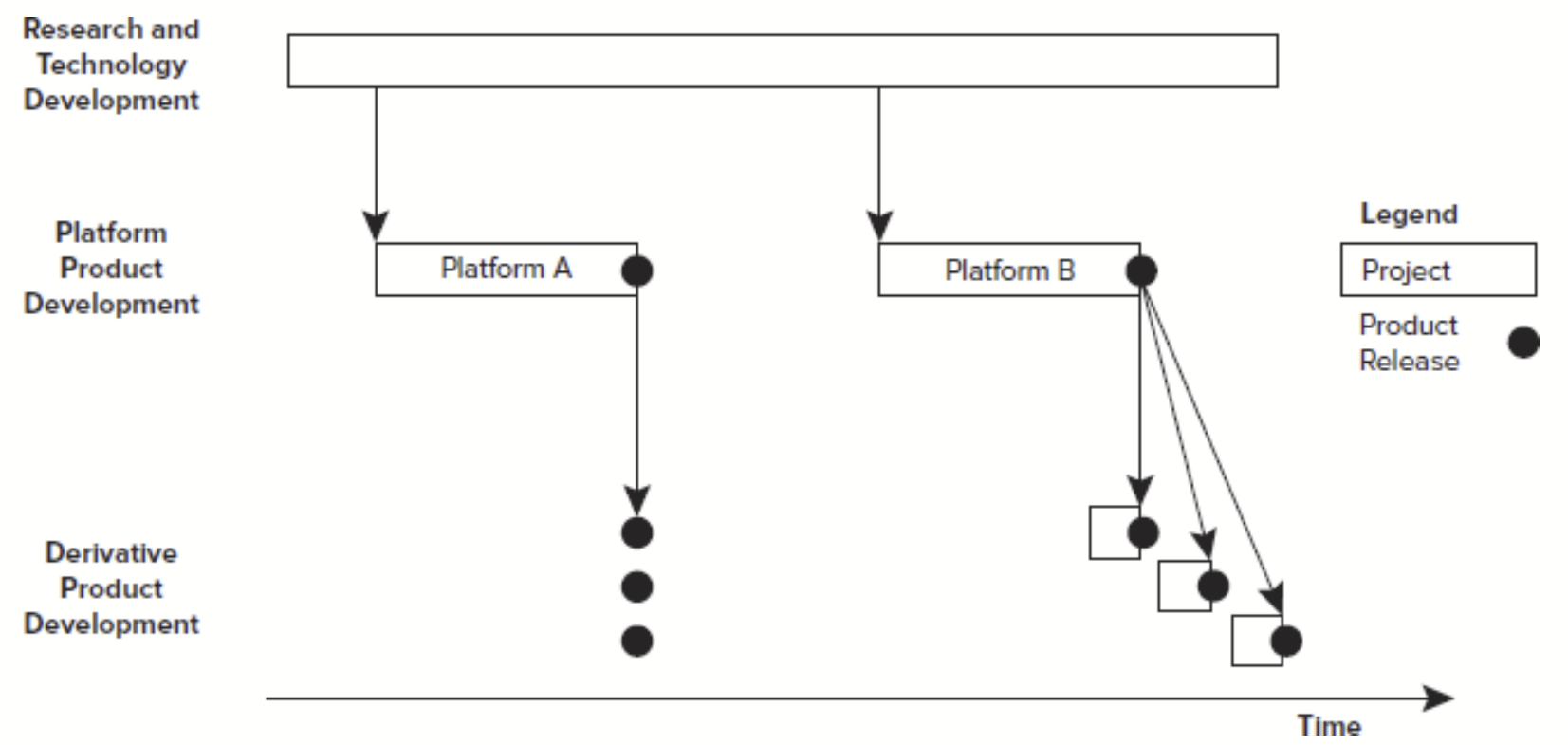
Technology roadmapping
A way to represent the expected availability and future use of various technologies. Coordinates tech development with product planning.
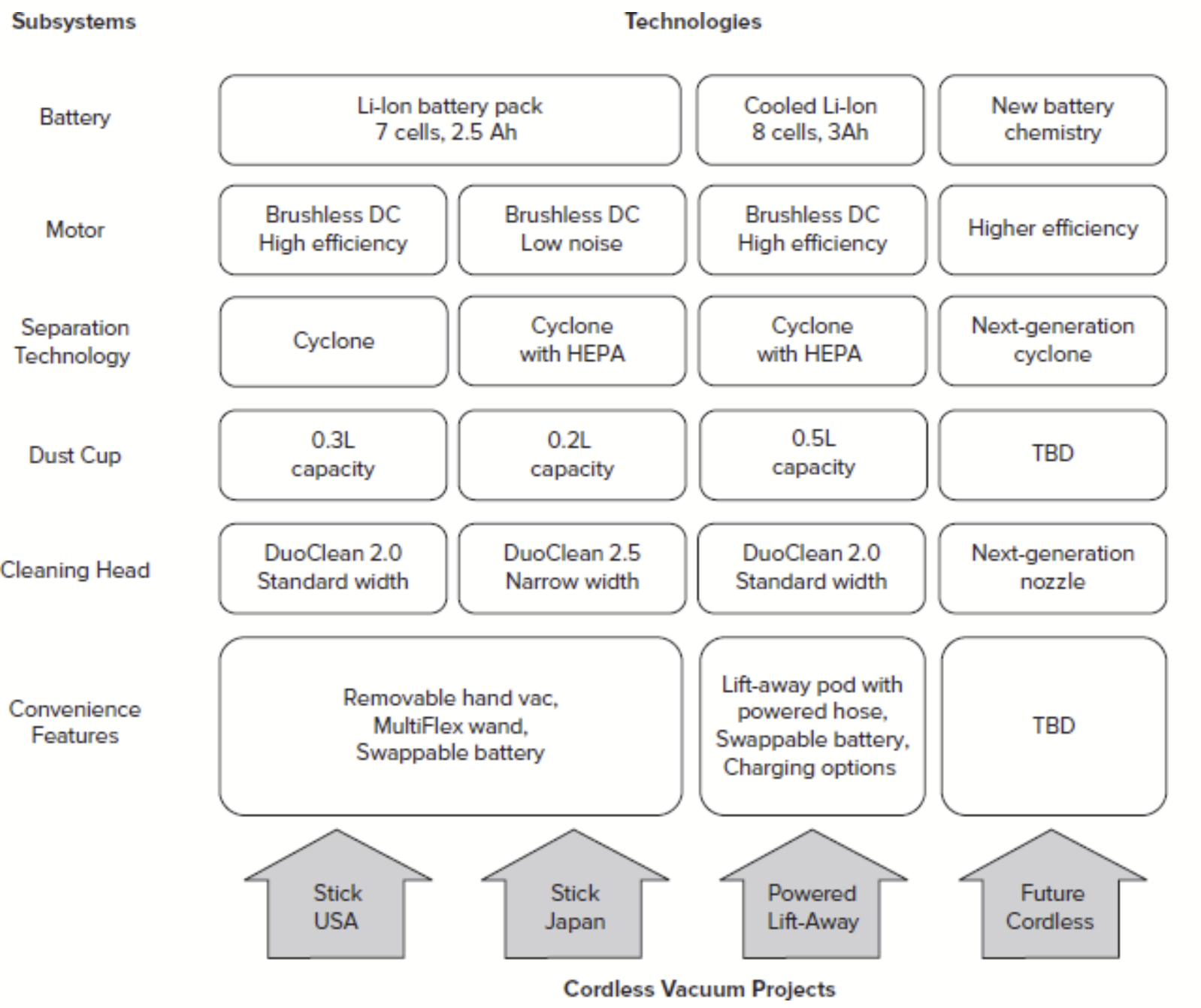
Criteria for evaluating fundamentally new product opportunities
Market size
Market growth rate
Competitive intensity
Depth of the firm’s existing knowledge of the market
Depth of the firm’s existing knowledge of the tech
Fit with the firm’s other products
Fit with the firm’s core assets and capabilities
Potential for patents, trade secrets, or other barriers to competition
Existence of a product champion within the firm
Product-process change matrix
Can illuminate imbalances in the portfolio of projects under consideration and in assessing the consistency between a portfolio of projects and the competitive strategy
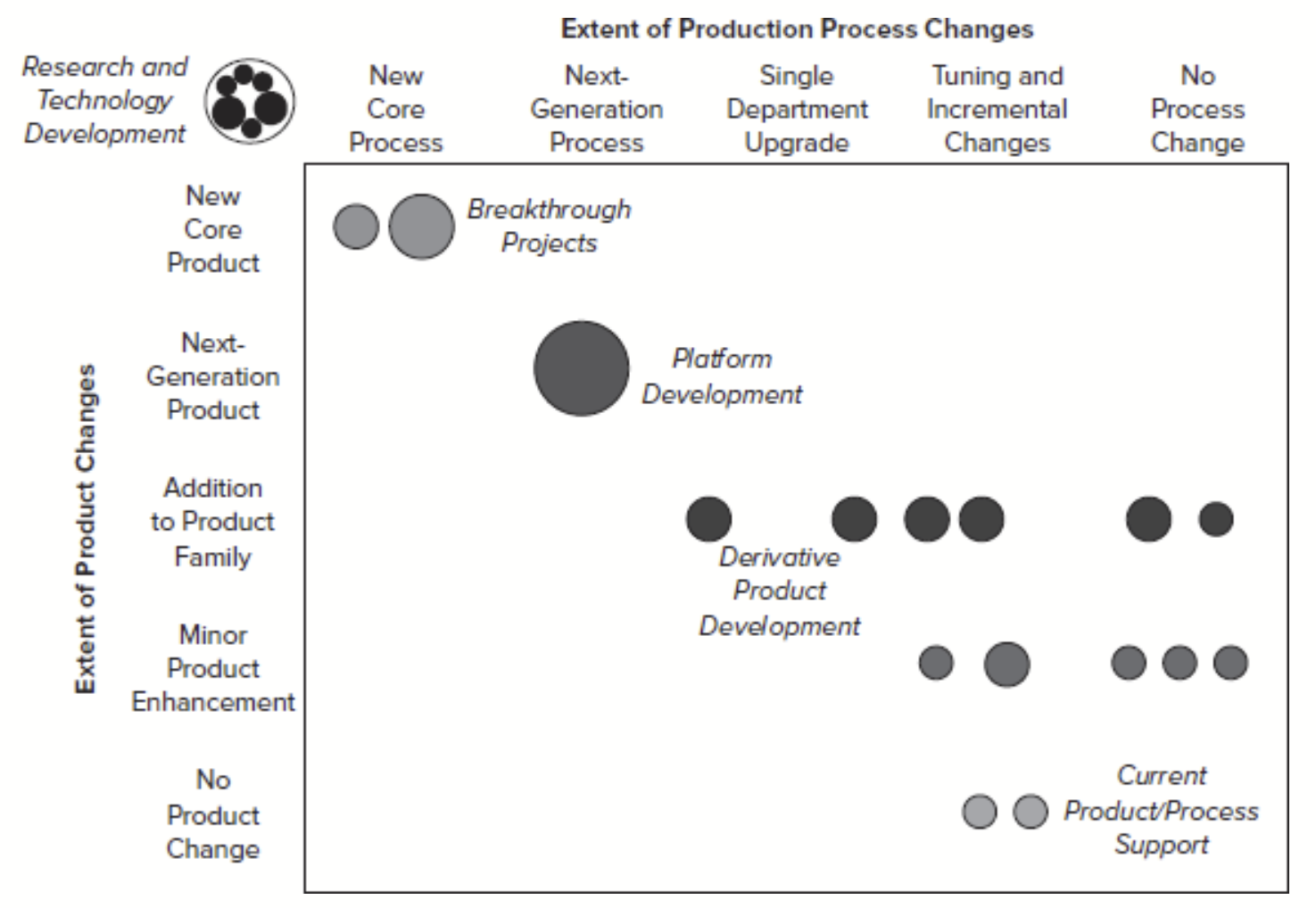
Determining the project timing
Timing of product introductions
Technology readiness
Market readiness
Competition
The product plan
The set of projects approved by the planning process, sequenced in time
Mission statement
Brief (one sentence) description of product
Benefit proposition
Key business goals
Target market for product
Assumptions and constraints
Stakeholders
Task network
Represents tasks as coupled, parallel, or dependent.
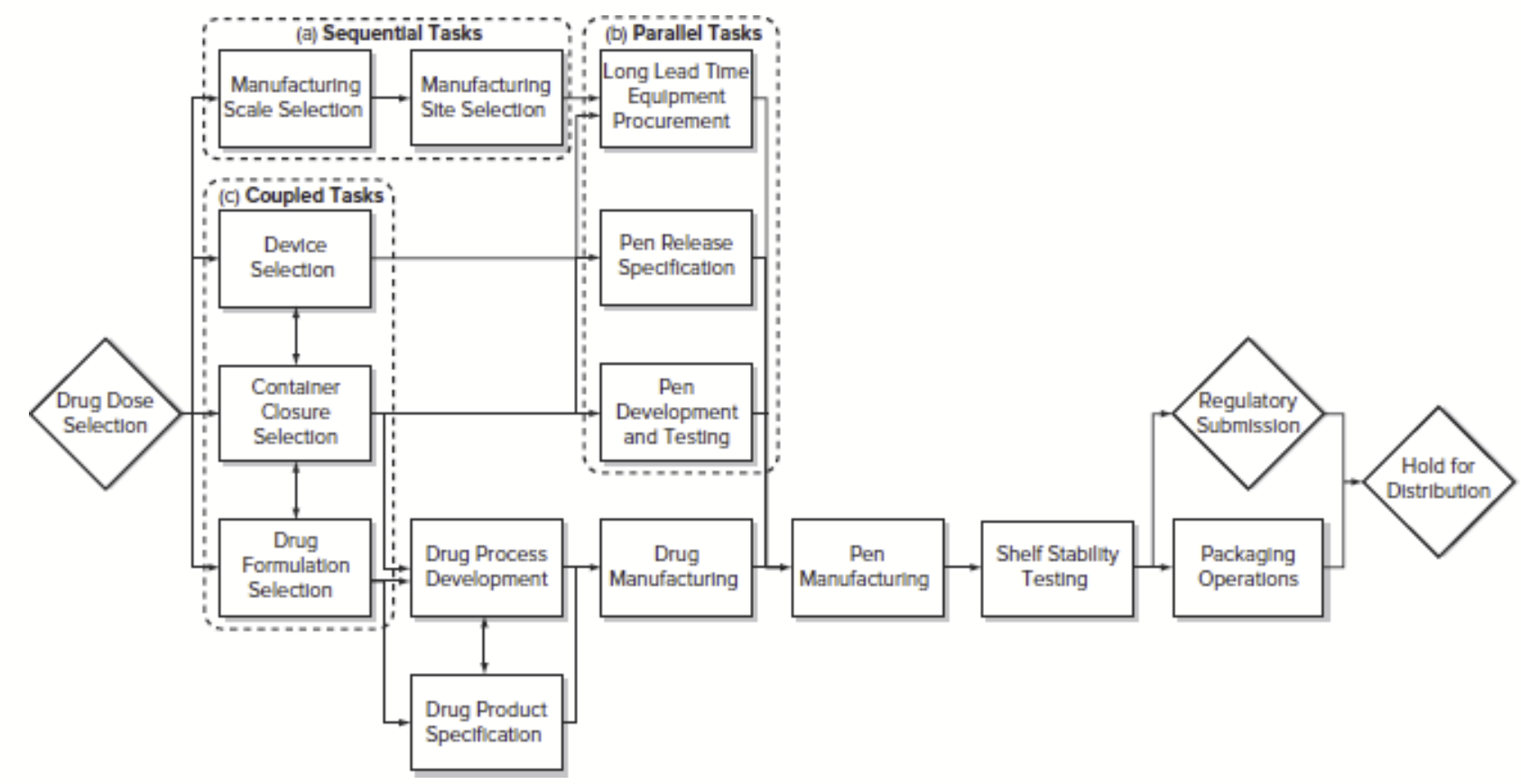
Design structure matrix
Used to analyze development projects modeled at the task level
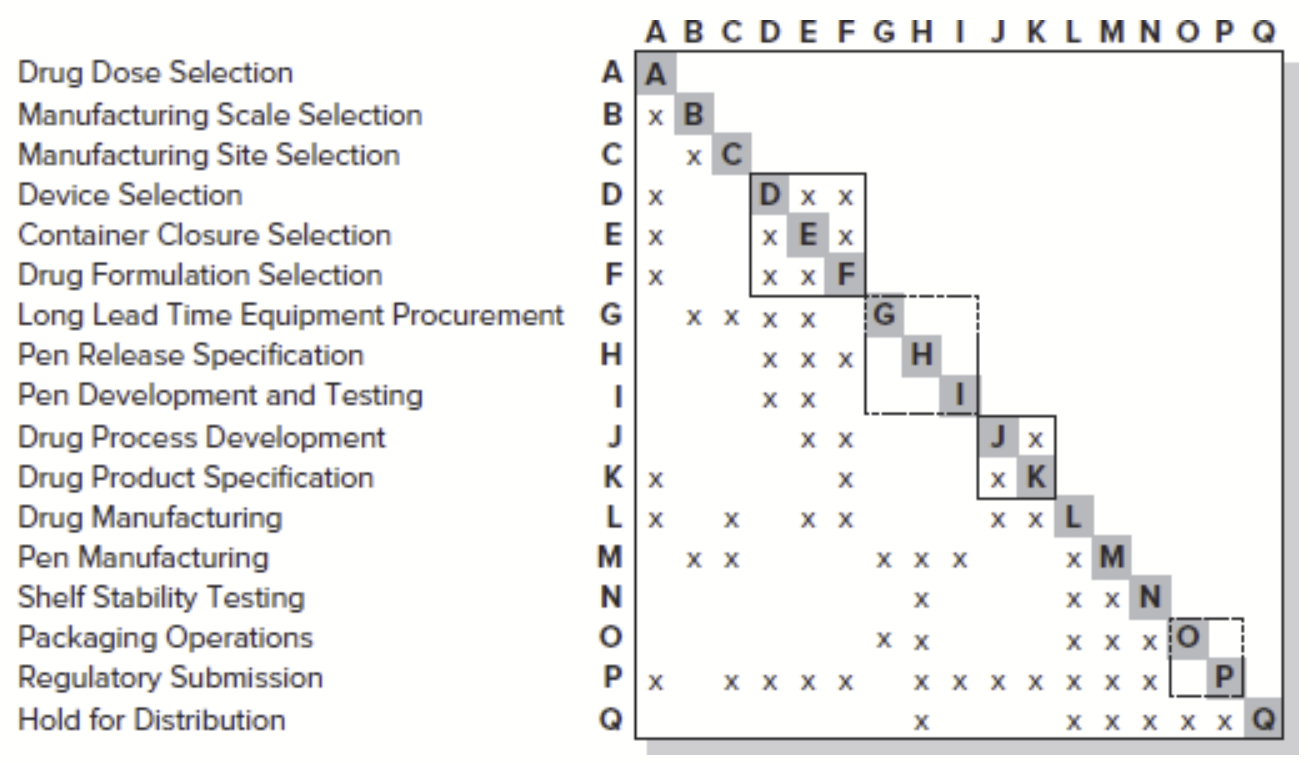
Gantt charts
Represents timing of tasks
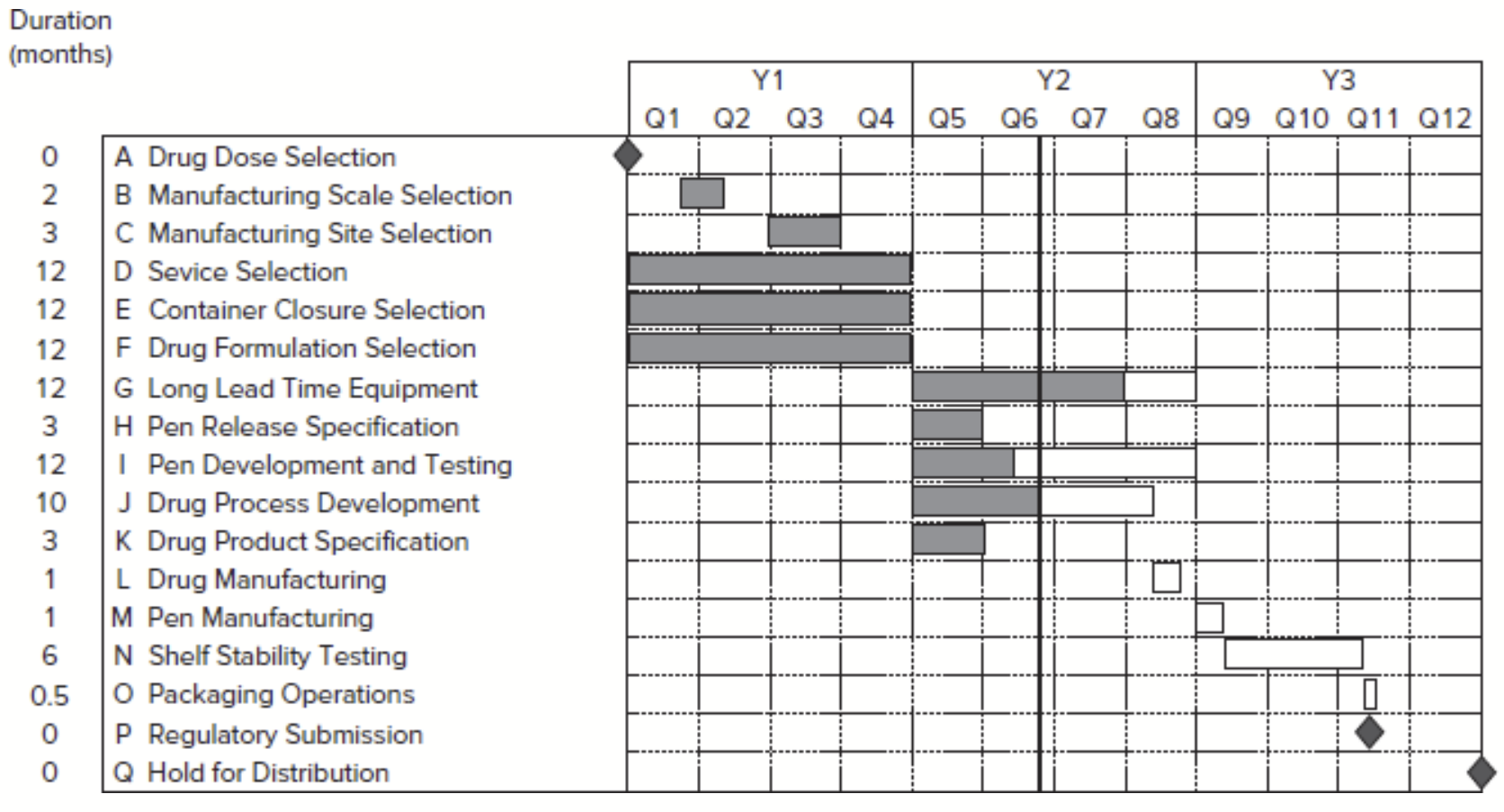
PERT chart
Program Evaluation and Review Technique. Represents both dependencies and timing
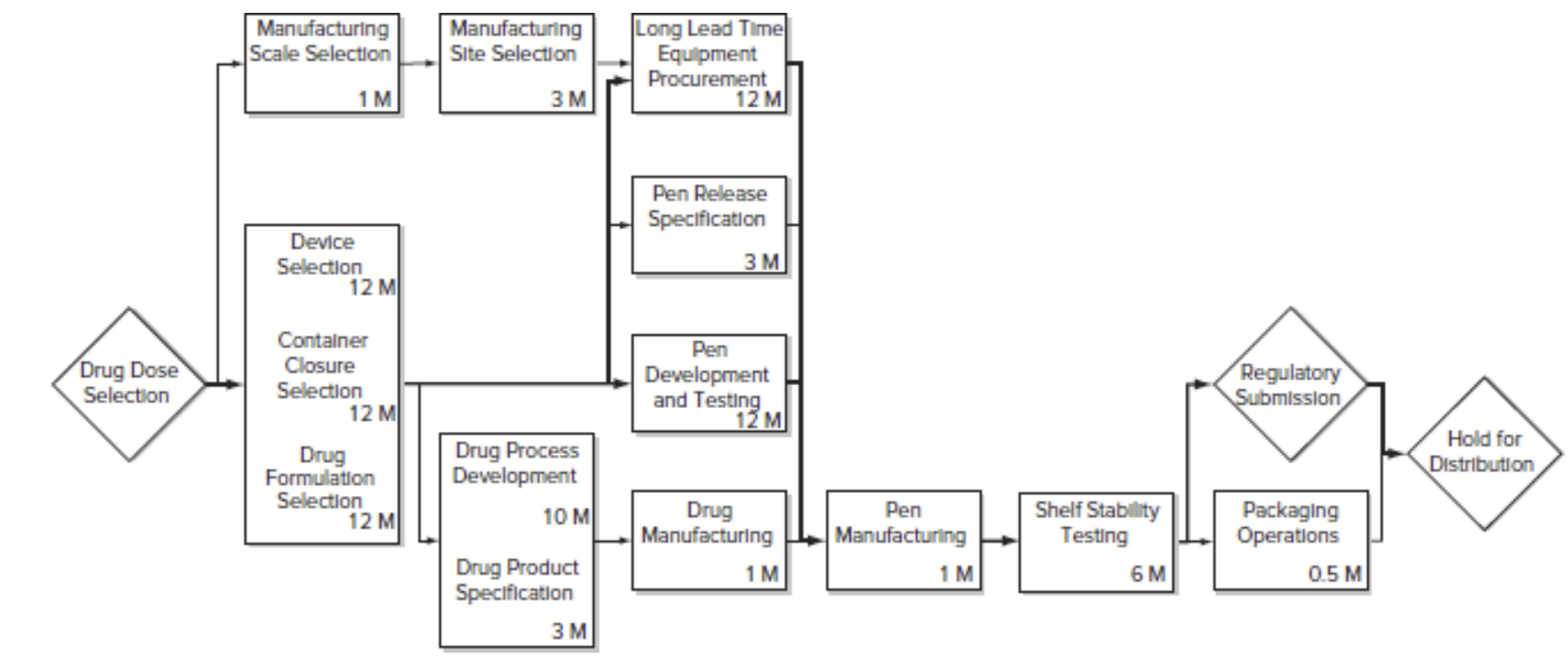
Critical path
Longest chain of dependent events.
Contract book
Represents an agreement between the development team and senior management about project goals, direction, and resource requirements.
Baseline project planning
Contract book
Task list
Team staffing and organization
Schedule
Budget
Risk plan
Methods of accelerating projects
Start the project early
Manage the project scope
Facilitate exchange of essential information
Decreasing time on critical path
Complete individual tasks on the critical path more quickly
Move tasks off critical path
Eliminate some critical tasks
Aggregate safety times
Eliminate waiting delays for critical path resources
Overlap selected critical tasks
Pipeline large tasks
Outsource some tasks
Complete coupled tasks quicker
Perform more iterations quicker
Decouple tasks to avoid iterations
Consider sets of solutions
Coordination mechanisms
Informal communication
Meetings
Schedule display
Weekly updates
Incentives
Process documents
Scrum teams
Corrective actions
Changing time/frequency of meetings
Changing project staff
Locating team together physically
Soliciting more time/effort from team
Focusing more on critical tasks
Engage outside resources
Change project scope/schedule
Life of a product
Design→production and delivery→use→end of life
Design
Project definition→product definition→conceptual design→product development
Production and delivery
Manufacture→assembly→distribution→installation
Use
Operate in sequence 1…N→clean→maintain (diagnose, test, repair)
End of life
Retirement→disassembly→reuse/recycle
Types of mechanical design problems
Selection
Configuration (packaging)
Parametric
Original
Variant
Redesign
Basic actions of design problem solving
Understand
Develop measures
Generate
Evaluate
Decide
Communicate
Designer’s languages
Semantic
Graphical
Analytical
Physical
Building a project plan
List of tasks
Objectives/deliverables
Estimate resources
Task dependencies
Estimate cost
Project management
The activity of planning and coordinating resources to achieve the goals of the project task deliverables
Product execution (control):
Coordinating and facilitating myriad tasks required to complete the project; to ensure seamless flow of information between tasks.